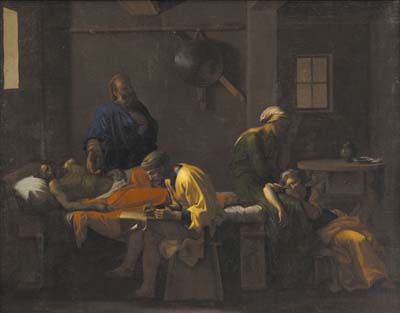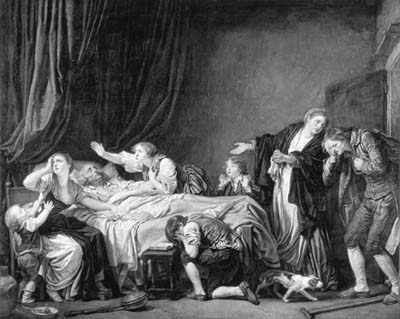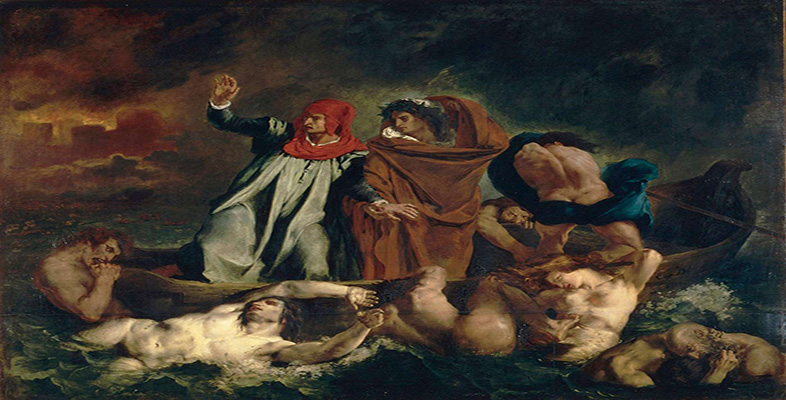2.5 Neoclassical – the established style
All of the disorientating effects of Delacroix’s composition were noted by his contemporaries, whose mindset was very much attuned to more legible treatments of picture space. This was exemplified by David, whose approach to painting represents a particularly austere interpretation of the neoclassical style established in eighteenth-century French art. It contributed to the political aims of the Revolution and First Empire, was admired and emulated by many artists, and remained influential in the Academy and critical circles of Delacroix’s time. It was derived from a restrained, dignified branch of Renaissance classicism, drawing principally on Raphael and popularised in France through the example of artists such as the seventeenth-century master Nicolas Poussin (see Figure 1). Later eighteenth-century artists such as Jean-Baptiste Greuze (see Figure 2) adapted Poussin’s neoclassical deathbed formula (a frieze-like composition structured around straight, horizontal lines and uncluttered spaces), which also found dramatic expression in David’s Death of Socrates. Moreover, in 1827, the year in which Delacroix’s Sardanapalus was being completed, Ingres, by then a famous representative of Neoclassicism, exhibited his Apotheosis of Homer (Plate 4). Although he was perceived as departing radically from David’s approach, he had nevertheless studied under him and was identified as adhering in important ways to the master’s neoclassical example.


Click to see Plate 4: Jean-Auguste-Dominique Ingres, The Apotheosis of Homer [Tip: hold Ctrl and click a link to open it in a new tab. (Hide tip)]
In many neoclassical paintings there is a clear, logical, planimetric structure to the composition: that is, a series of implied horizontal and vertical planes (straight layers or ‘slices’ through the imagined three-dimensional space of the painting) along which the whole is structured, so that the composition remains taut, stable and balanced. This stability was often achieved partly through the use of the straight horizontal lines of classical architecture, which locked figures and objects into a geometric ‘grid’. Figures, derived from antique statuary, are idealised rather than realistic, and arranged hierarchically so that heroes and protagonists and the planes on which they are located are clearly dominant. Neoclassical compositions of the late eighteenth and early nineteenth centuries express the traditional values of a classical style: simplicity, unity, order, idealism, balance, symmetry and a general respect for rules and reason. They also adhere to the traditional classical practice of studying antique statuary and the posed academic model as a basis for figure drawing: if ‘nature’ was to be ‘imitated’ this had to be in a highly selective, idealising and refining way. The neoclassical style developed and championed by David offers a particularly striking version of the classical characterised by a stark linearity: clearly delineated, outlined or contoured figures and objects, standing out from a neutral, non-distracting background, and often arranged horizontally so that they line up directly in front of the viewer.
The surface finish of a neoclassical painting is smooth, so that there is no distracting surface ‘dazzle’ or appeals to the senses of touch and sight that would detract from intellectual impact. Eloquent gesture, designed to assist narrative intelligibility, is also characteristic. In the years preceding the French Revolution, the Neoclassicism introduced by David, with its stripped bare, linear, austere style and republican overtones, had been controversial (see Plate 5, The Lictors returning to Brutus the Bodies of his Sons). David’s pupils – Girodet, Gérard, Guérin and Ingres – subsequently assisted their master in consolidating the status of Neoclassicism by adapting its potential to the requirements of the Napoleonic empire. Generally, this elevated style became accepted as appropriate to the morally and intellectually elevated history genre favoured by the Academy and required for grand, public display. It suited a broad cultural preference for the archetypal and the didactic. By the time Delacroix began his career as a painter, Neoclassicism had lost much of its Davidian radicalism and had become a style with which the Academy was both familiar and comfortable.
Click to see Plate 5: Jacques-Louis David, The Lictors returning to Brutus the Bodies of his Sons
